If you’re anything like me when you first started smoking weed, you thought all grinders were basically the same, but the truth is there are many types of weed grinders.
Various products work well in different ways, and there are actually certain types I’ve come to prefer over the years.
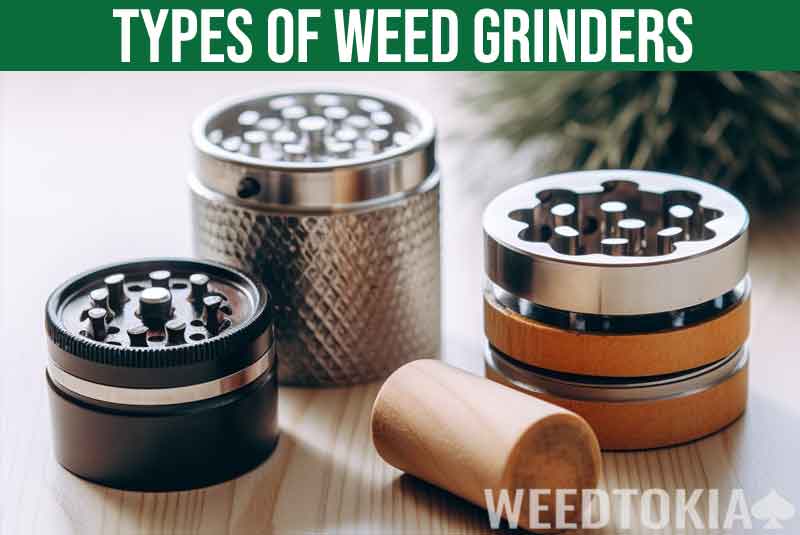
Depending on the type and material of grinder you have, its capabilities will vary greatly. We’ll break grinders down logically, from the simplest type (1 piece) to the most complex (4 piece and electronic grinders).
Let’s take a closer look at what’s out there and help you find the perfect grinder for you.
Table of Contents
Different Types Of Weed Grinders Explained
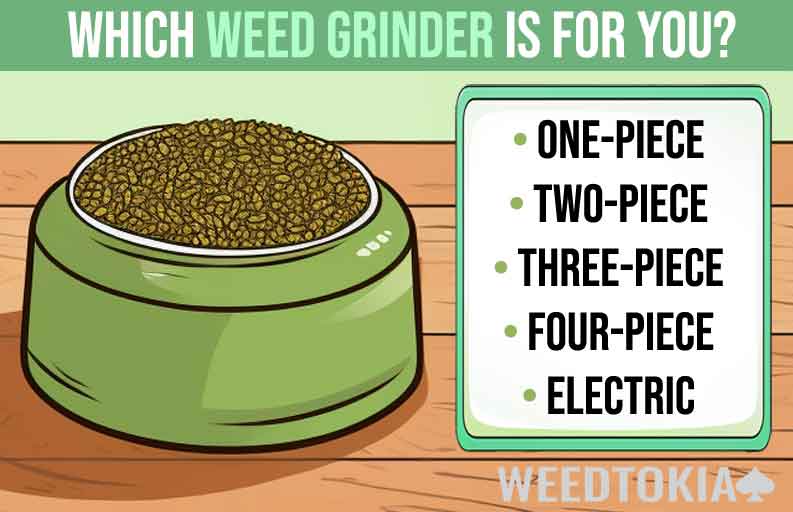
The first types of grinders are ones that come with varying numbers of pieces. You might figure that you only need one item to grind cannabis flowers, but the more pieces your grinder has, often the more functionality it will offer.
1. One-Piece
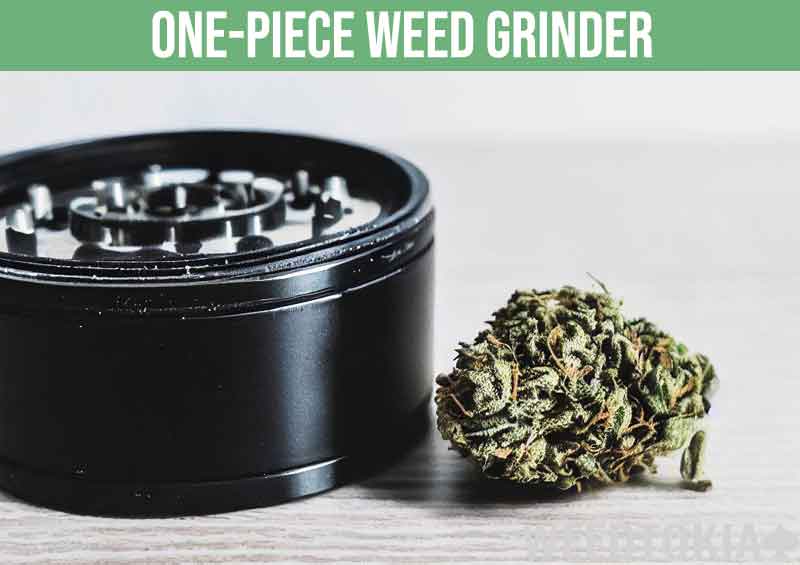
A grinder card is also called a one-piece grinder. This grinder option features a flat body with small grating stops you can use to grind down cannabis flowers.
All grating pieces are evenly spaced to create a consistent cutting surface. Think of one of these grinders as a cheese grater but for weed.
But every one-piece grinder is built differently. You’ve got to not only hold the surface well in your hand, but you’ve also got to move it over the leaf you’re grinding. Some leaves might be too thin, so it might not be practical to cut a leaf with one of these items.
You’ll find plenty of holes in one of these grinders, but they’re always scattered around differently. Some spots might be in one unique pattern. You’ll have to look around to see how different grinder cards work if you’re going to use one.
Watch for how you’re handling one of these grinders if you plan on using one. Wearing protective gloves might help, what with those grinding spots being sharp.
Placing the leaf on a flat surface while moving the grinder over it can also work, but you’d have to add some protective material underneath it all to keep the grinder from scratching the surface.
But what would someone want to use a one-piece grinder if there’s so much hassle?
You might do this because you want more control over your experience or you want to get a better connection with your plant. You might enjoy your bud more if you do it this way.
In short, a one-piece grinder can be too much of a hassle for some. But those with experience with these grinders will have an easier time making them work.
2. Two-Piece
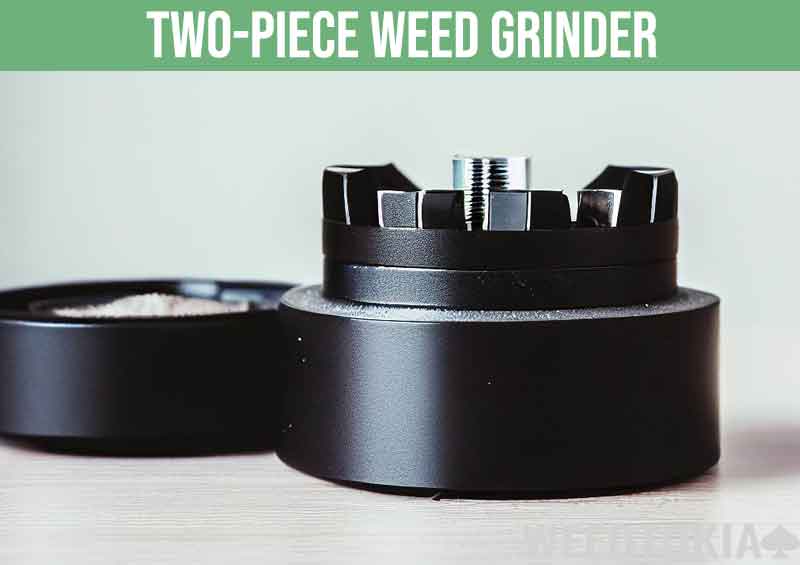
A two-piece grinder is what most people think of when they imagine a weed grinder. It is similar to a one-piece model, but this version has a spot that can collect your buds. These two pieces are:
- The grinding surface you’ll use to grind your flowers alongside a lid to cover the grinding layer
- A bottom that collects all those grindings
The design makes it easier for you to keep all your buds in one place. You can close up the grinder when you add the flower, and then you’ll twist the top part over the grinding surface to cut the flowers.
This layout is an effective setup, and it doesn’t take as much time as if you used a one-piece item. But you’ll still need to clean out the grinder on occasion, as it might contain lots of small crevices where you’ll get some buds stuck.
The bottom should also be smooth and easy to clean out. The design should keep thick parts of a flower from seeping through and getting in the way of the rest of the stuff in your joint.
You’d also have to be careful when opening up your grinder. Since there are fewer pieces, it’s easy to lose control and have all the stuff in your collection chamber slip out and get everywhere.
3. Three-Piece
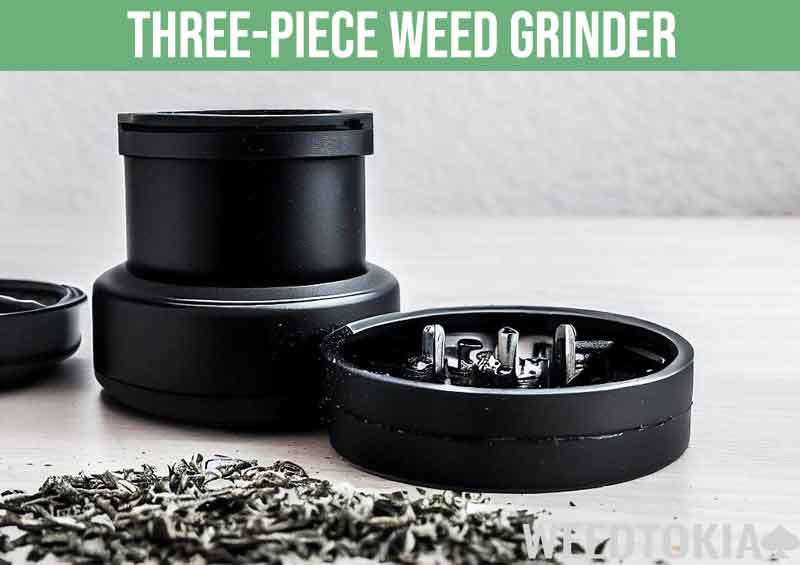
The next type of weed grinder is a three-piece grinder. Here’s what you’ll find in a product like this one:
- A lid with a grinder and room for your flower
- Storage chamber for the ground bud
- A separate space for the kief
A one or two-piece grinder will allow those sticky kief bits to seep into the collection chamber as you’re separating them from the rest of the flower while grinding. But a three-piece unit will have an ultra-fine sieve that will keep the kief bits from going into the chamber.
You can use your kief in many ways after you finish grinding your leaves and cleaning the grinder. You can take that kief leftover after grinding your plant and sprinkle it over your strain or inside a rolled-up joint.
The compound produces a smoother burn that lasts longer. There’s also the option of directly smoking the kief to get the most intense results, although you should only use as much as you can handle at a time.
A three-piece grinder is best for people looking to enjoy weed smoke without using as much at once. Since the kief you collect can improve the potency of most weed smokes, you’ll have an easier time conserving what you have.
You’ll have to clean your three-piece grinder out more often if you want it to work well.
Sticky or resin-coated flowers tend to gunk up these grinders a little faster. Washing out the grinder when you collect enough kief will help you keep from getting too much stuff stuck in one place.
4. Four-Piece
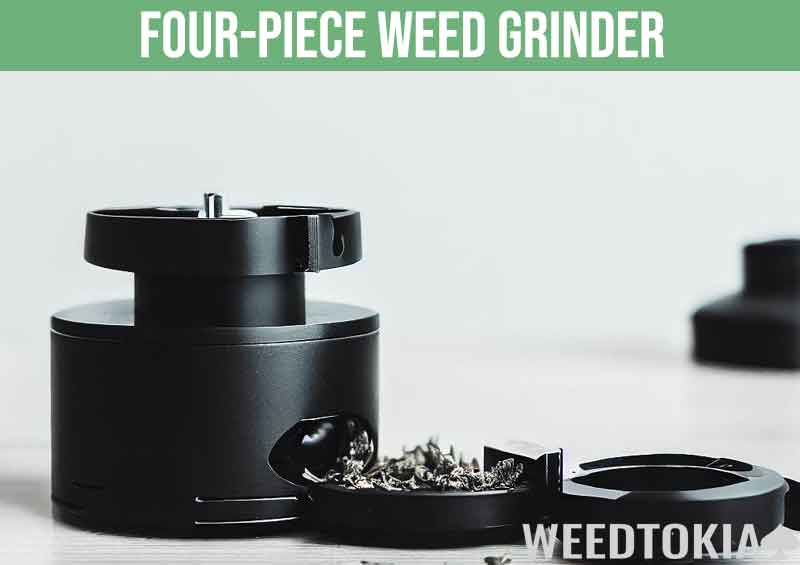
You can enjoy more versatility when you use a four-piece weed grinder.
A four-piece grinder is similar to a three-piece one, but there’s an additional chamber in the middle part. This separate chamber lets you store your flowers well, plus you can add rolling papers and other stuff if you desire.
The four-piece grinder comes with these parts:
- A lid with a grinding surface
- A chamber for the ground bud
- A smaller opening for the kief
- An additional storage base for flowers and other items
While the functionality of the four-piece grinder is similar to a three-piece one, you’ll enjoy a four-piece unit if you want to combine strains.
You can also use this if you are trying to get a bud ready while on the go since you can safely store more of the things you need for a joint.
5. Electric
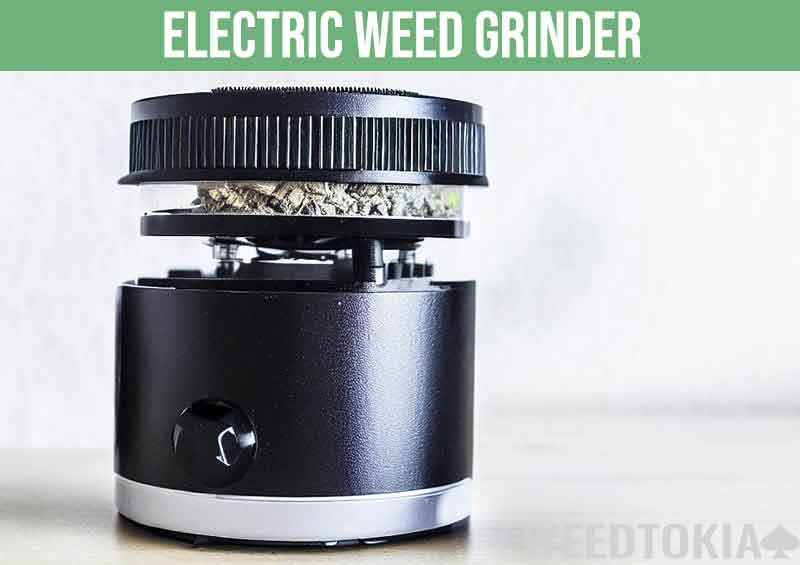
Say bye to manually grinding your weed. Electric weed grinders will automatically chop it down into small pieces, so you don’t have to grind it yourself.
These can be on the smaller side or big, like in this picture. You probably don’t need a big one, as they’re mostly used by dispensaries that need to grind a lot of weed for their pre-rolls.
I personally enjoy grinding my own weed; it gives me pleasure to get it done myself.
But if you smoke all the time and you’re annoyed having to grind your weed constantly, these are pretty supreme.
They’re on the pricier end, and most come with an electric plug, so they’re not really portable.
If you’re someone who smokes weed a lot or doesn’t have great dexterity in your hands, an electronic type of weed grinder might be perfect for you. I have a couple of friends with electronic grinders, and they really enjoy using them.
What Types of Materials Are Weed Grinders Made Of?
The second part to see when finding types of weed grinders is to look at what your design includes. You’ll find many grinders made of different materials, but you’ll have to look well at what you see when getting something to work.
1. Plastic
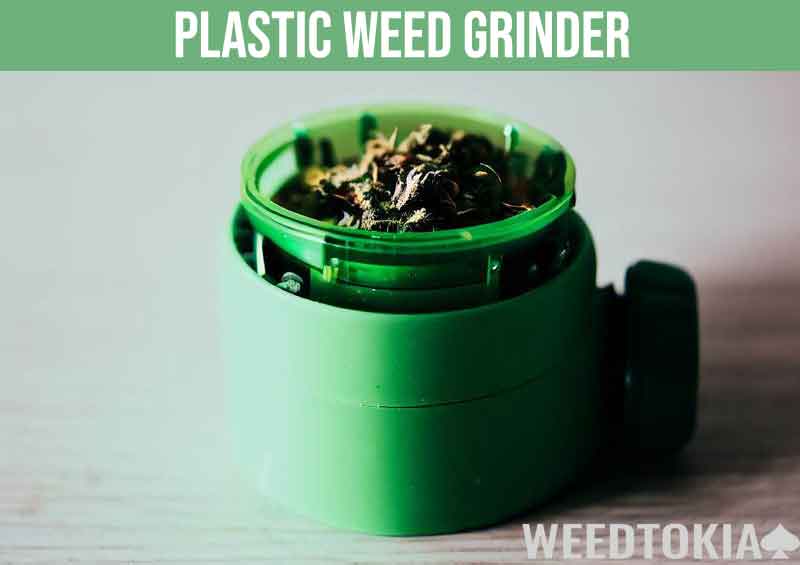
The most common option when considering different types of weed grinders is a plastic one. You can buy a plastic grinder if you want something cheaper.
Plastic grinders are easier to manufacture and are available in a vast array of colors. Some plastic products are transparent, so you can see how well you cut your buds while working.
But plastic grinders aren’t always as great as you wish. The plastic teeth can dull fast, making them less effective.
Those teeth are also more fragile than others, so they can break apart fast. You’ll have a tougher time breaking down your flowers when the plastic grinder starts wearing out.
In short, a plastic grinder may be cheap, but it’s also less effective than you might expect.
It’s no surprise that a cheaper option won’t work too well when compared with others. The appearance of your grinder might also be rather cheap, making you look less refined.
2. Wood
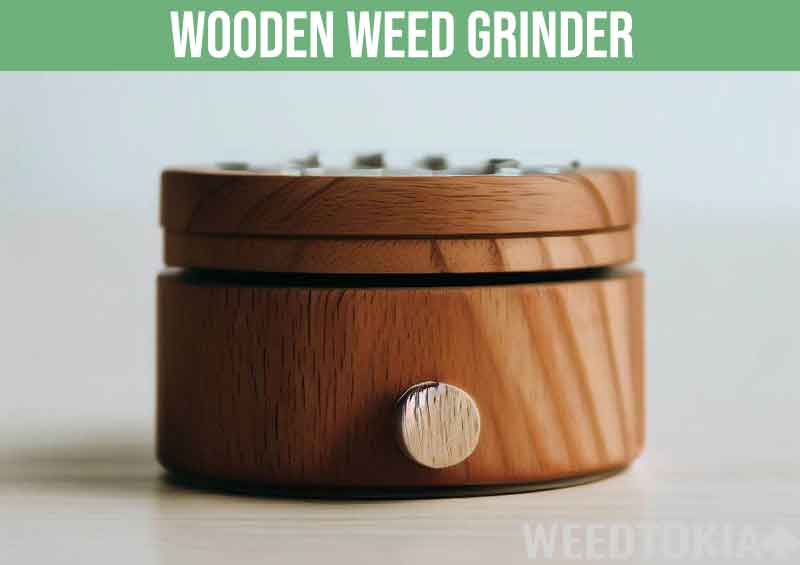
The idea of having a weed grinder made of something other than metal sounds unusual. But it’s easier to use one than you realize. A wooden weed grinder is a good choice to find.
Your wood grinder will feature some wooden pegs on the inside. When grinding your herb, those pegs will move through the flower and start tearing it apart from all the force that moves inside. The design creates a natural cut that won’t pull the flower too much.
The layout provides a more comfortable approach to cutting. You can find wooden weed grinders with various elaborate designs. You could even order a customized one with your name carved in it.
But you’ll have to maintain your wood grinder a little more often. Wood can retain moisture and other materials more than metal. You’d have to clean off the wood grinder after each use, plus it has to be thoroughly dried to keep the surface from warping.
Cleaning is also necessary for keeping odors from sticking around, which is useful if you’re not looking to combine strains.
Those wood pegs will wear out after a while too. How long your wooden grinder will last will vary over how often you use it and how intense you are with it, so watch what you do here.
Ironically enough, wooden grinders might cost more because of the detailed designs they can feature.
You’ll get a great-looking grinder, but that doesn’t mean it will last forever. The refined and classy nature of your grinder might make it a worthwhile choice when you’re looking for a quality grinder model.
3. Aluminum
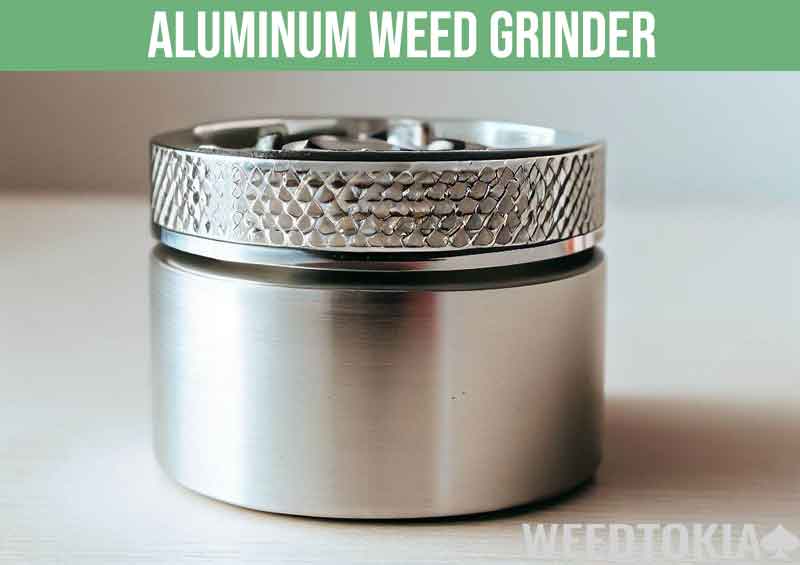
Metal is useful for a weed grinder, as metal-cutting materials can shred through cannabis leaves quite well.
But aluminum is the best metal you can utilize when getting a grinder ready.
Aluminum is sturdy and can cut through leaves well; plus, it is lightweight. Aluminum is also easier to clean, which is useful when you’re working with stickier buds.
Aluminum grinders are typically less expensive because aluminum is a more plentiful metal and easily recyclable.
This choice works well if you’re new to weed and need something simple.
4. Titanium
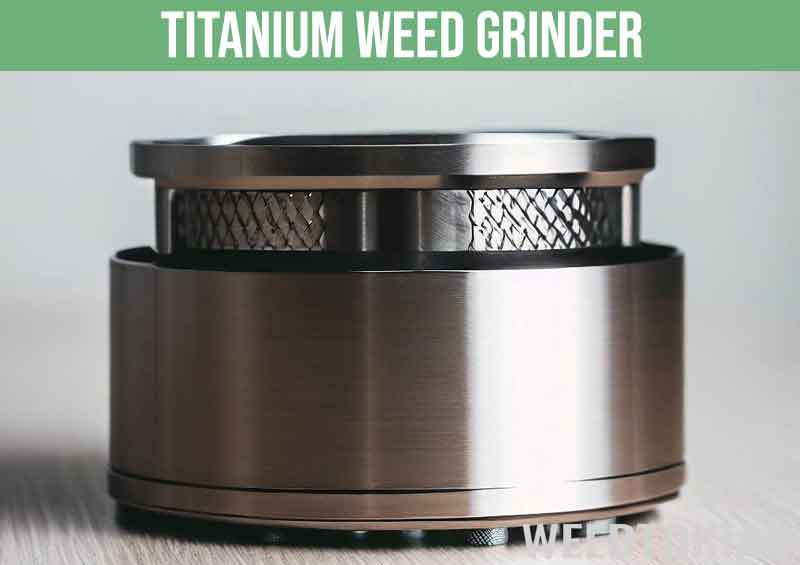
You’ve also got titanium as a useful option. Titanium is a sharper metal that can produce a finer cut.
The trim helps you grind down your flowers a little more, giving you more materials in the storage chamber.
You can use a titanium grinder if you’re trying to get an extra-thin joint ready.
But titanium models typically cost more, what with this metal not being as common.
5. Stainless Steel
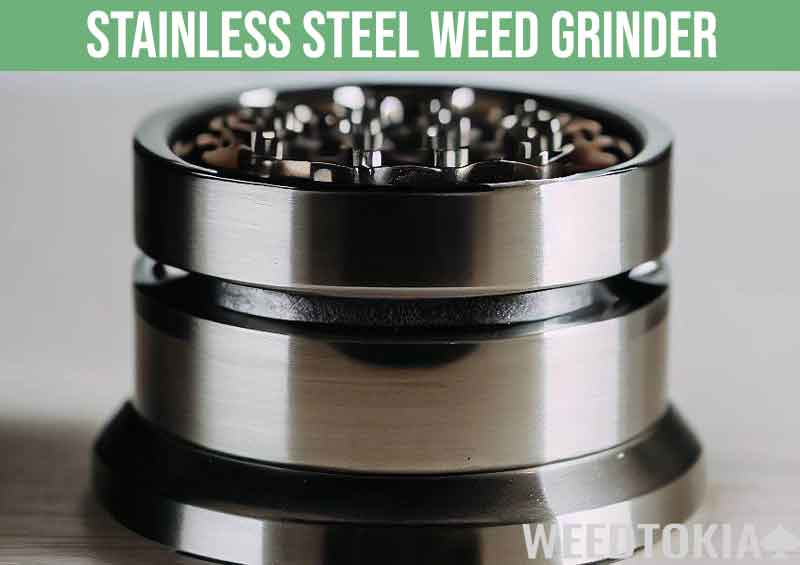
You can also use stainless steel when finding a metal for your weed grinder.
Stainless steel is a firm and sturdy compound that doesn’t rust like regular steel because the design has a chromium material working as an alloying agent.
Stainless steel is useful, but make sure you’ve got a food-grade stainless steel material ready.
Type 304 stainless steel is a food-grade material that contains a healthy mix of nickel and chromium.
What this means for you is that the surface is easy to clean, plus the body isn’t going to interfere with the flavor or potency of your weed.
This type of steel is also used in many kitchen-cutting materials, so it’s ideal for your weed-cutting needs.
Do All Weed Grinders Work the Same?
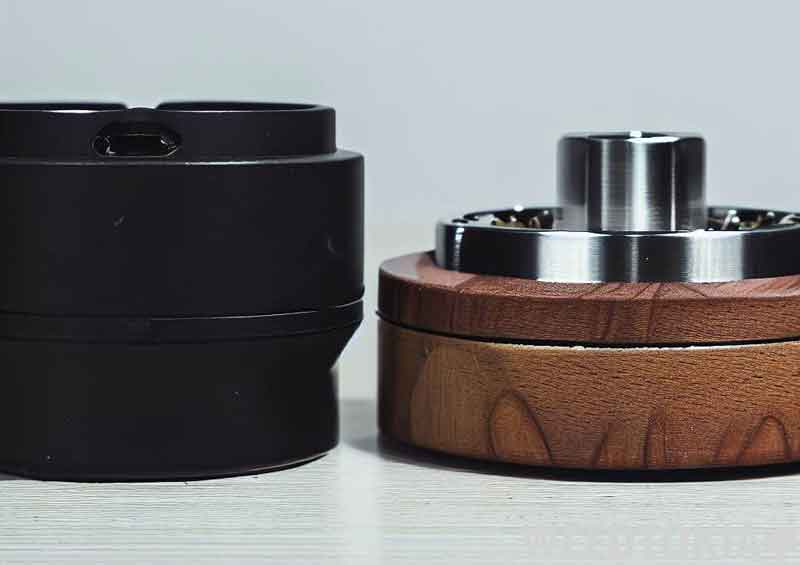
Yes, all weed grinders work the same. You break down the cannabis flower apart and place the small bits between the grinding teeth. You then rotate the grinder around a few times until the flower falls into the storage chamber.
All those broken-down things you get from the grinder can work in bowls, joints, and whatever else you prefer.
The basic mechanism is the same all around, but the material you use and the number of pieces in your grinder will make a difference.
Some grinders are more elaborate but can be more effective in cutting down those leaves. The materials you find might also influence how well you’ll get a quality cut.
Does It Matter How Big the Grinder Is?
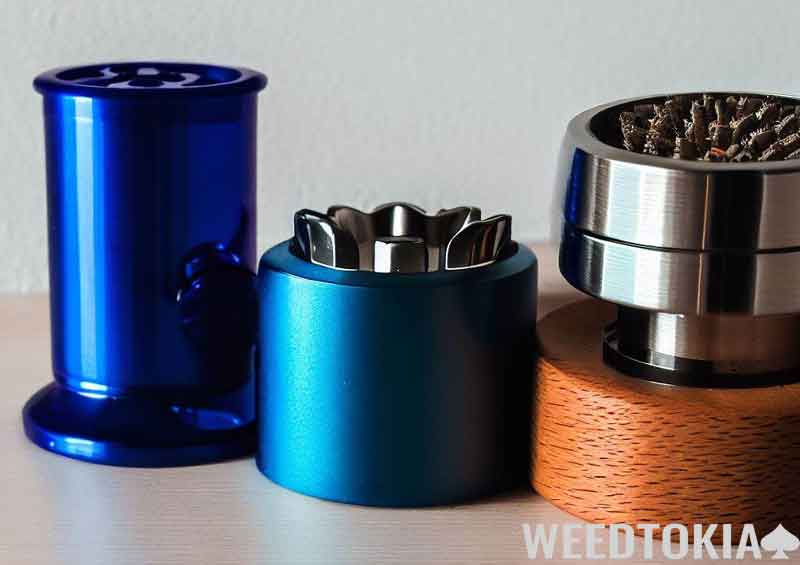
It doesn’t matter how large your weed grinder is, but you’ll still find some grinders in varying sizes.
Most grinders are circular, and they’ll have a diameter of about 2 to 3 inches. For one-piece grinder cards, the design might be about three to four inches long.
A larger grinder that is more than 3 inches in diameter is also useful for cases where you’re trying to roll more joints at once.
You can even use it if you’ve got multiple people with you, as everyone’s going to want in on whatever you’ve got.
Be sure whatever grinder you pick is something you’re comfortable using. The design should be easy to grip so you can grind down your flowers well enough.
What Does The Inside Of A Grinder Look Like?
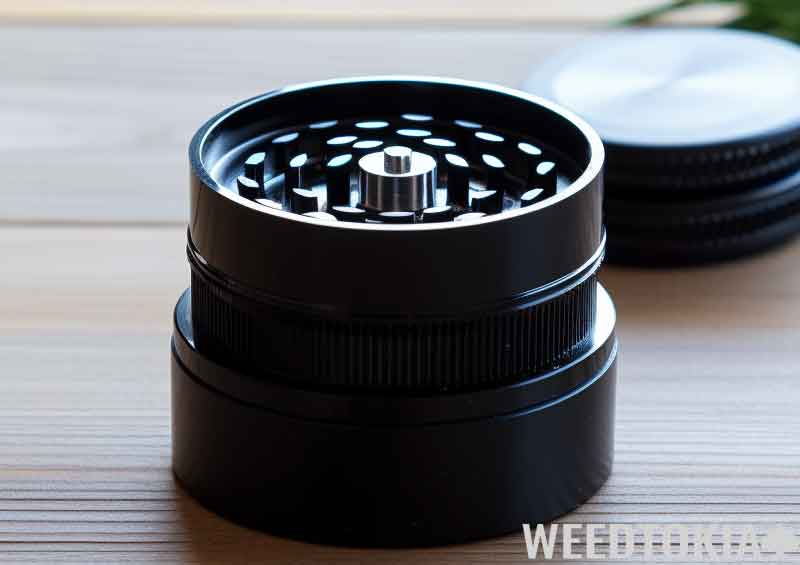
The inside of a two, three, or four-piece grinder should have a cutting surface that has enough pointy spots to where it can cut through your cannabis leaves.
The cuts should be even enough to where you can clear out a leaf with ease.
Some grinders will have pegs that will collect your leaves and keep them in place.
The cutting materials inside a grinder will go between those pegs, cutting through the leaves. This setup works well if you secure the leaves inside the space well enough.
Some plants are resinous and might stick a little more.
These plants can stick inside the grinder well, so watch how this might happen when trying to get a material working for your use.
Can The Weed Become Less Potent From Using a Grinder?
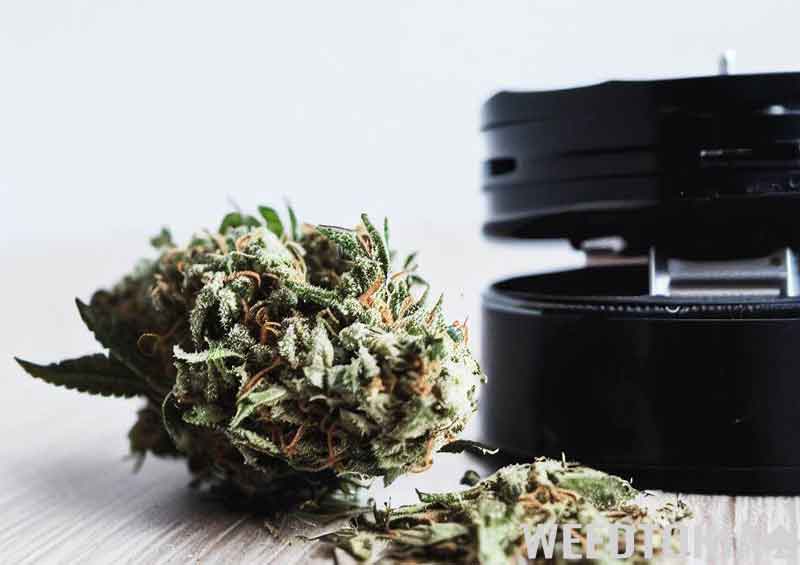
There are many potent weed strains out there, so you might worry about whether your strain will be less powerful when you grind the weed.
The good news is that your weed isn’t going to become weaker when you cut your materials right.
Proper use of your grinder will help you cut more items well without risking anything wearing too much.
You’ll still need to collect the kief well to improve how well your weed works.
A three or four-piece grinder will work well for keeping the kief separate, which is necessary when trying to keep some of the more potent parts of a strain intact.
What About Magnets?
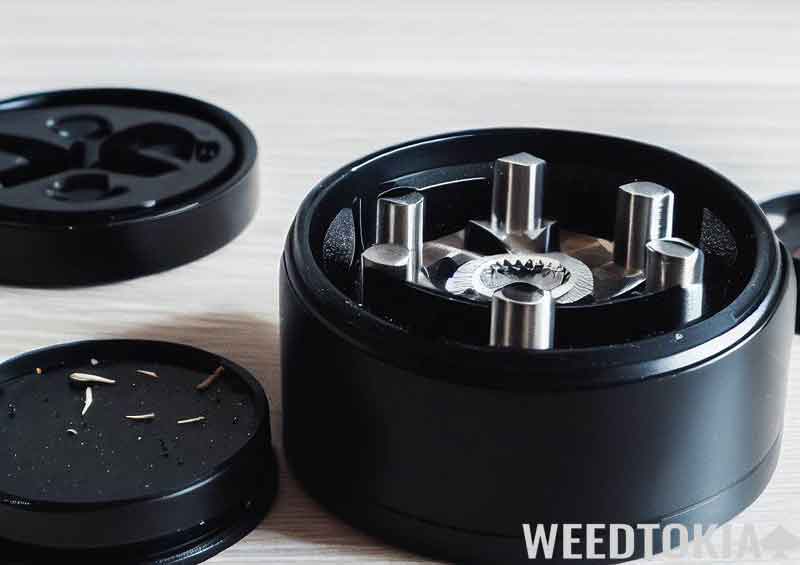
Magnets are available in many weed grinders. You might be worried that a magnet would negatively influence how well your weed works and feels.
But you shouldn’t have to worry, as magnets can be more effective in helping plants grow and stay healthy. A small magnet can appear in the middle part of the inside of your grinder.
The magnet will help you keep the body closed up while in use. The force keeps the grinder from coming apart while grinding things, so you’ll keep everything intact.
The good news is that magnets aren’t going to harm how well your cannabis plant works. If anything, a magnet might do more to help. Magnetic forces can help plants grow by triggering the formation of cell proteins, producing a more efficient growth cycle.
While your cannabis leaves won’t become enhanced when inside a grinder with a magnet, the magnet itself won’t hurt the leaves either.
You can always place any cannabis seeds you have on a flat magnet for a few days and then plant those seeds within a day after moving them off the magnet to improve how well the seeds can grow new leaves.
What About Moon Rocks?
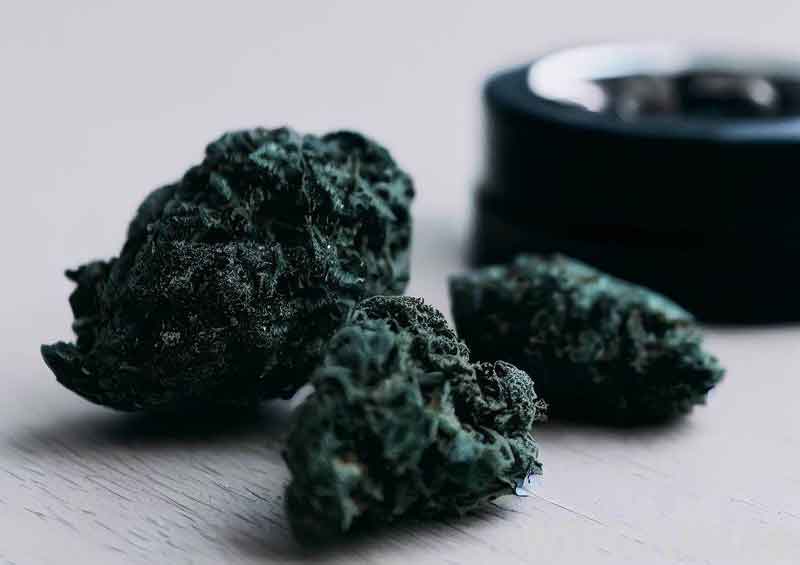
All the weed grinders you’ve read about are useful, but you should avoid trying to use moon rocks in a grinder.
While combining many strains to create a moon rock can be exciting, you’ve also got to use enough kief to get a moon rock ready.
The body of your moon rock will be intense and harder to cut.
Grinding your moon rock with your fingers is best, as you won’t risk clogging your grinder up with random things.
Don’t Forget The Effort
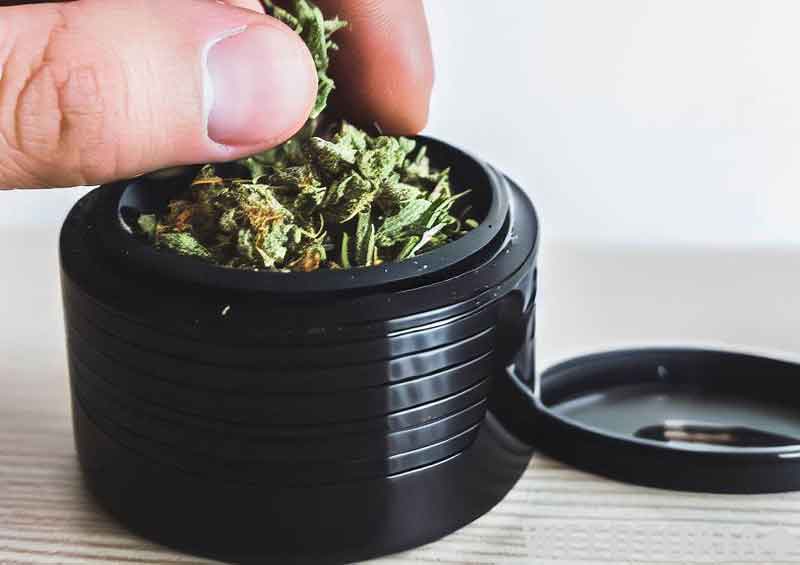
Your last thing to see when looking at types of weed grinders is to watch for how much effort you’ll put into using a grinder. Today’s grinders are light and easy to rotate, as their cylindrical bodies can work well.
Meanwhile, a single-piece grinder requires more effort to use. Since you’ve got to hold the cutting card in one hand and the leaf in another, you’ll have to work harder to get everything cut up well enough.
The effort you’ll use in cutting your leaves will be critical if you have any dexterity loss or pain in your hands.
Anyone who wants to use cannabis to relieve pains caused by arthritis will benefit from a quality weed grinder, but the material itself shouldn’t be something that only makes those arthritis pains worse.
A Final Note on Weed Grinders:
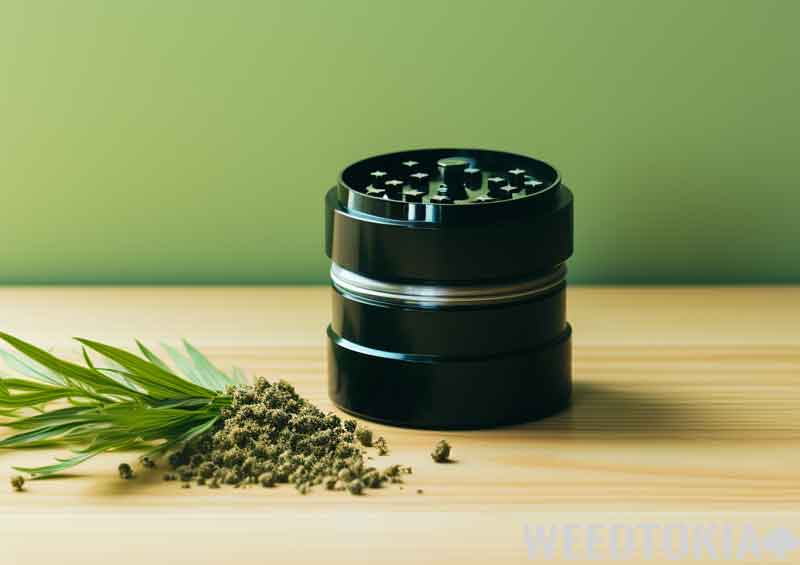
Weed grinders are convenient for how they can help you cut down your cannabis flowers, but as you now know, you shouldn’t assume every grinder is the same. Watch how many pieces are in your grinder, and look at what the grinder is made of before choosing something.
Every grinder is different in things like how well they cut through leaves, how you maintain them, and what components are inside each one. You’ve got many choices, but the rules for using them and how you clean them are always different.
Make sure you find a choice that’s suitable for you. You might find your weed a little more enjoyable when you have a grinder that works well for your desires. If you’re anything like me, you’ll find your grinder to be a sentimental piece of art at some point.